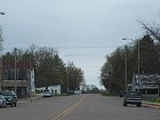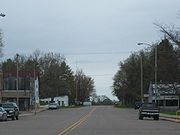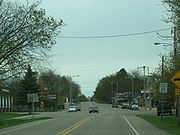
Almond, Wisconsin
Encyclopedia


Portage County, Wisconsin
Portage County is a county in the U.S. state of Wisconsin. As of 2000, the population was 67,182. Its county seat is Stevens Point. The United States Census Bureau's Stevens Point Micropolitan Statistical Area includes all of Portage County.-Geography:...
, Wisconsin
Wisconsin
Wisconsin is a U.S. state located in the north-central United States and is part of the Midwest. It is bordered by Minnesota to the west, Iowa to the southwest, Illinois to the south, Lake Michigan to the east, Michigan to the northeast, and Lake Superior to the north. Wisconsin's capital is...
, United States
United States
The United States of America is a federal constitutional republic comprising fifty states and a federal district...
. The population was 459 in the 2000 census.
History
Incorporated in 1905, the town originated when Jacob Meyers from Mohawk Valley, New York, started a stagecoach and freight route between Berlin and Stevens Point. He needed a stop for the horses between route so he set up a barn and inn on the site of what is now Almond. The U.S. government signed a treaty with the Menominee Indians ceding land in central Wisconsin in 1848, which opened up the area to settlement. A post office was established on July 8, 1850, at the stagecoach stop. James F. Moore, a native of Almond N.Y., became postmaster.Geography
Almond is located atAccording to the United States Census Bureau
United States Census Bureau
The United States Census Bureau is the government agency that is responsible for the United States Census. It also gathers other national demographic and economic data...
, the village has a total area of 1.0 square miles (2.7 km²), all of it land.
Demographics
As of the census of 2000, there were 459 people, 189 households, and 126 families residing in the village. The population densityPopulation density
Population density is a measurement of population per unit area or unit volume. It is frequently applied to living organisms, and particularly to humans...
was 445.2 people per square mile (172.1/km²). There were 199 housing units at an average density of 74.6 persons/km² (193.0 persons/sq mi). The racial makeup of the village was 96.30% White, 0.22% African American
African American
African Americans are citizens or residents of the United States who have at least partial ancestry from any of the native populations of Sub-Saharan Africa and are the direct descendants of enslaved Africans within the boundaries of the present United States...
, 0.22% Native American, 0.22% Asia
Asia
Asia is the world's largest and most populous continent, located primarily in the eastern and northern hemispheres. It covers 8.7% of the Earth's total surface area and with approximately 3.879 billion people, it hosts 60% of the world's current human population...
n, 0.22% Pacific Islander, 2.61% from other races, and 0.22% from two or more races. 7.19% of the population were Hispanic
Hispanic
Hispanic is a term that originally denoted a relationship to Hispania, which is to say the Iberian Peninsula: Andorra, Gibraltar, Portugal and Spain. During the Modern Era, Hispanic sometimes takes on a more limited meaning, particularly in the United States, where the term means a person of ...
or Latino
Latino
The demonyms Latino and Latina , are defined in English language dictionaries as:* "a person of Latin-American descent."* "A Latin American."* "A person of Hispanic, especially Latin-American, descent, often one living in the United States."...
of any race.
There were 189 households out of which 32.3% had children under the age of 18 living with them, 48.7% were married couples
Marriage
Marriage is a social union or legal contract between people that creates kinship. It is an institution in which interpersonal relationships, usually intimate and sexual, are acknowledged in a variety of ways, depending on the culture or subculture in which it is found...
living together, 13.2% had a female householder with no husband present, and 33.3% were non-families. 30.2% of all households were made up of individuals and 17.5% had someone living alone who was 65 years of age or older. The average household size was 2.43 and the average family size was 3.00.
In the village the population was spread out with 26.1% under the age of 18, 10.2% from 18 to 24, 23.5% from 25 to 44, 24.2% from 45 to 64, and 15.9% who were 65 years of age or older. The median age was 36 years. For every 100 females there were 92.9 males. For every 100 females age 18 and over, there were 82.3 males.
The median income for a household in the village was $37,857, and the median income for a family was $47,500. Males had a median income of $34,861 versus $20,972 for females. The per capita income
Per capita income
Per capita income or income per person is a measure of mean income within an economic aggregate, such as a country or city. It is calculated by taking a measure of all sources of income in the aggregate and dividing it by the total population...
for the village was $18,104. About 10.5% of families and 10.4% of the population were below the poverty line, including 19.7% of those under age 18 and 11.9% of those ages 65 or older.

